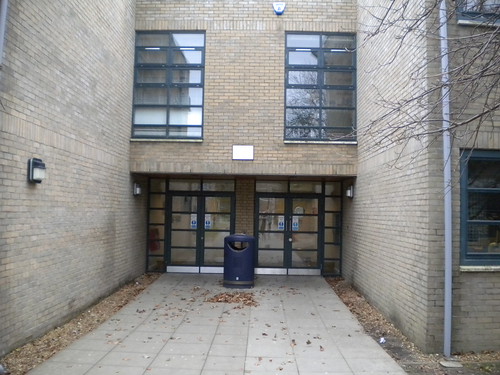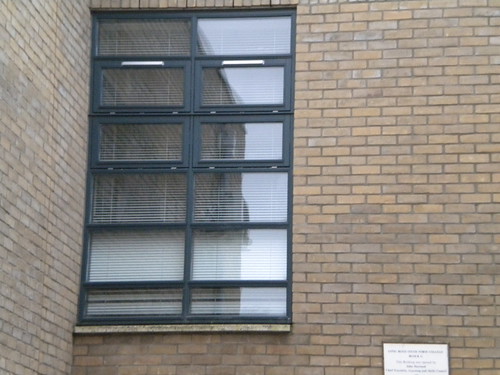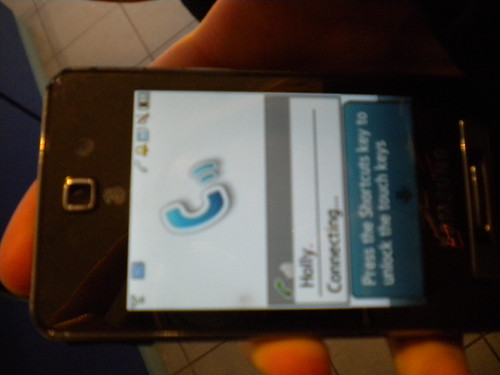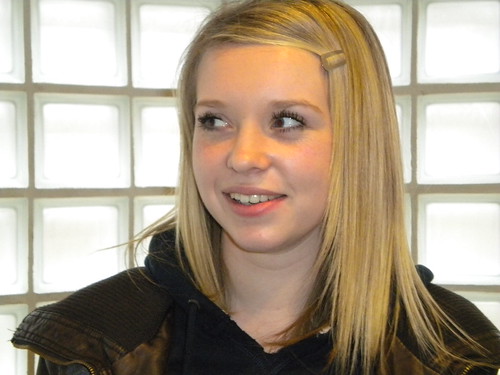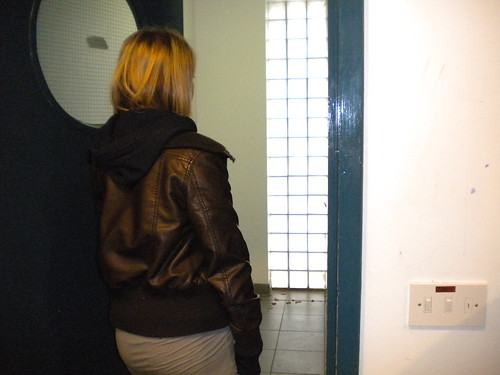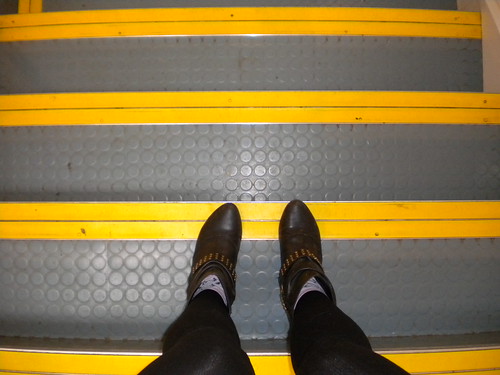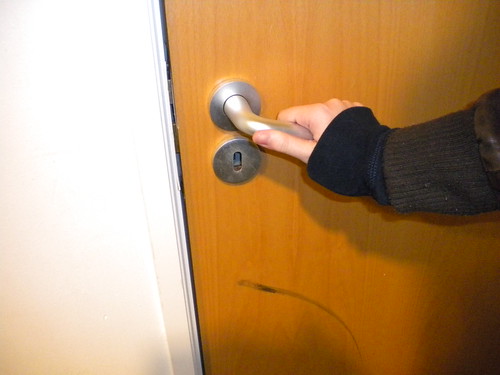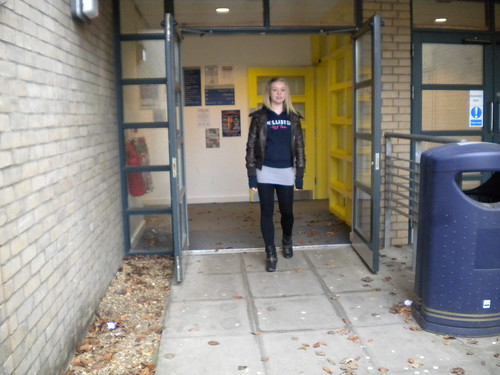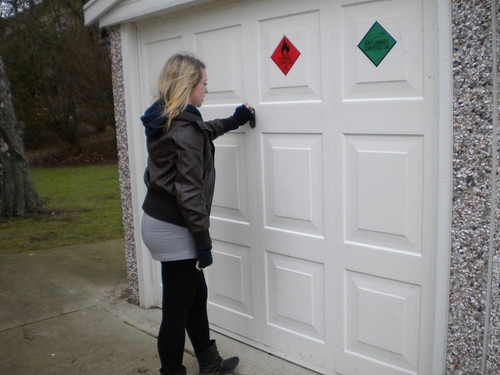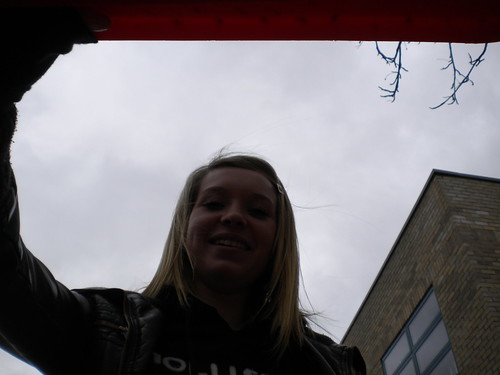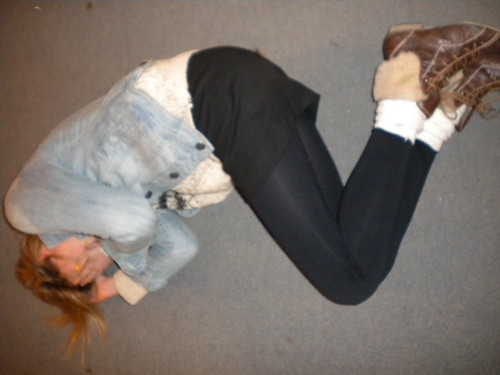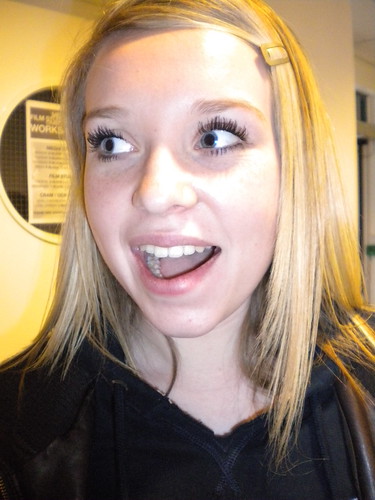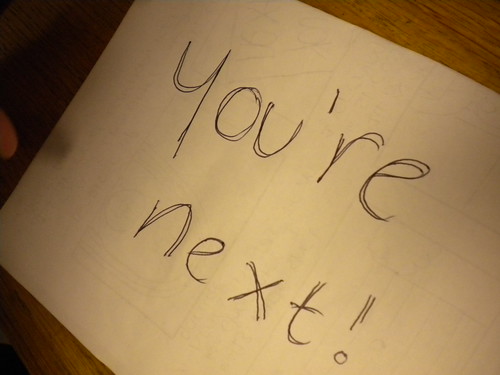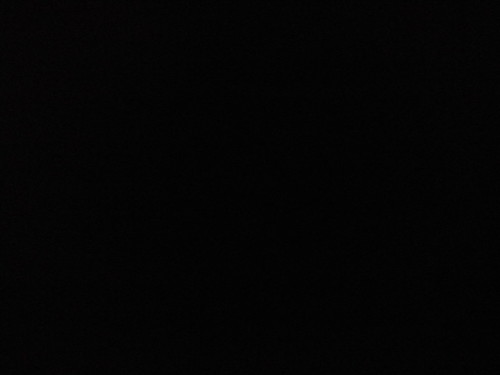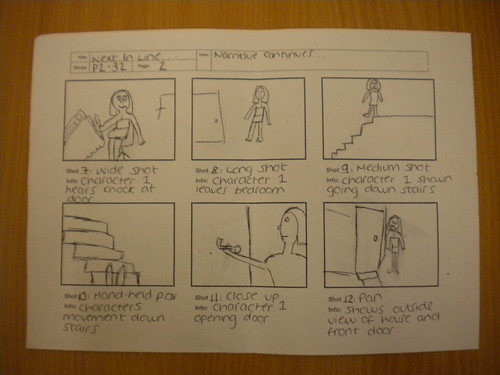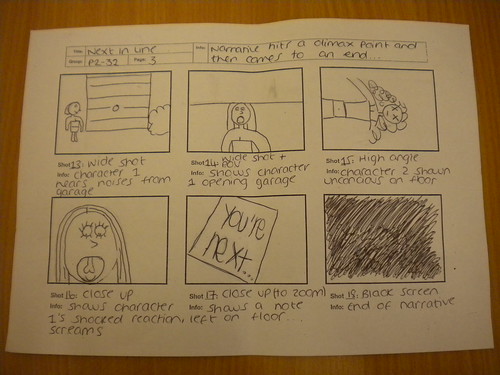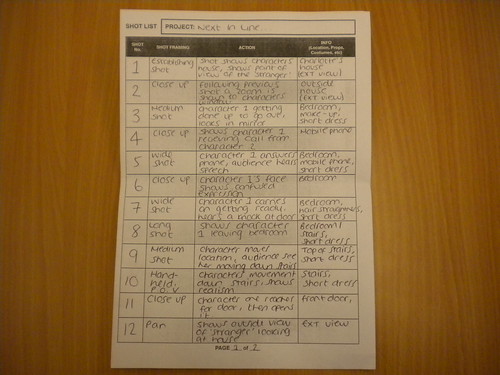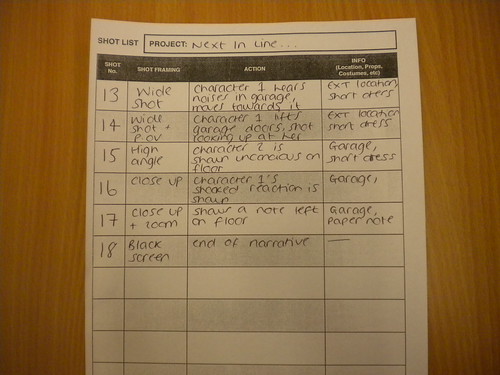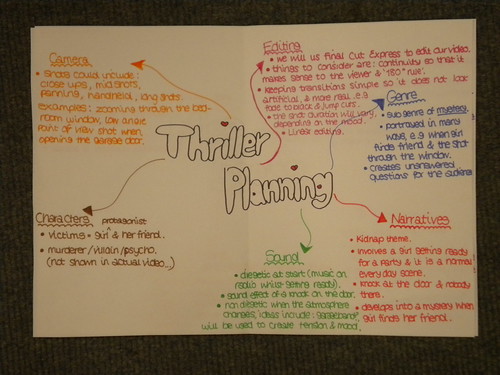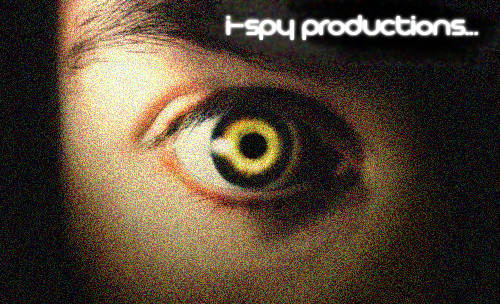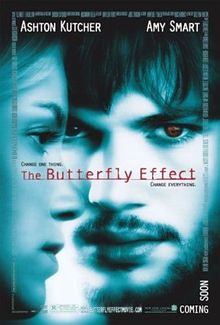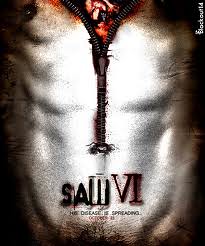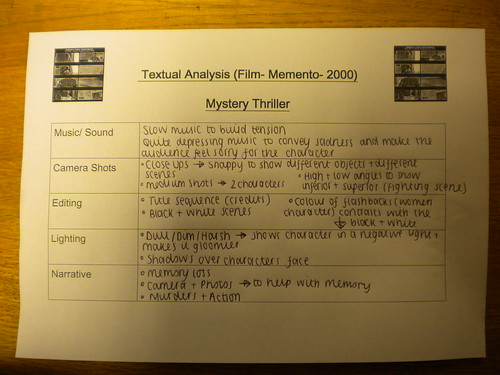After the production stage it is now important that to make our audience aware that our film is available to watch, by doing this we will use advertising as informing people of a new upcoming film which is needed to ensure the success of the movie; there are many different ways we could go about doing this.
Posters
These are used to catch the eye of audience so bright colours and interesting visuals are a must. They need to be informative of our thriller and include relevant information such as the title and date of release. When displaying these we could use billboards, buses, cinema's and public places to draw in the target audience.
Trailers
When advertising a film production companies use a trailer as a common method to inform people of a film they might choose to watch. The trailer is an essential part of advertising a new film, it outlines the plot in less then 2 minutes giving the audience a snippet of what the film will be like. The main characters are also introduced, if they are famous actors and actresses then advertising that they're in the film will add to the popularity of the movie. Places for the advertisement to be shown is on the television, in cinemas and YouTube.
The Internet
Film Review Websites are popular visited websites on the Internet today, as an example 'Rotten Tomatoes'. Here, many people are able to write their own review on a movie which is then discussed by different people with different opinions.
Having a good review for our thriller would encourage others to watch it and if they enjoy it they could spread the word to more people, this is known as 'word of mouth' advertising, an effective yet free method.
Friday 8 April 2011
Stategies For Marketing & Advertising Our Film!
Friday 18 March 2011
Peer Feedback...
1. Describe the type of camerawork which has been used. Do you think it's effective? Why?
There was a good variety of camera shots including; high angle, mid-shots, close ups and zoom in. The close ups help to build tension throughout out opening. The tracking shot helped to convey and establish the location. Our point of view shot was clearly showed from the characters perspective.
2. What type of sounds have been used? Does it work well with the visuals?
The diegetic sound (speech) was at the right volume and was very clear. The soundtrack went well with the visuals and helped to create tension throughout.
3. How has the mise-en-scene been constructed? Does it have an impact on the genre?
Props: you can easily tell what type of character she is! Props included wine, phone, straighteners and the sign. The lighting outside could have been a bit lighter in order to see more. However the inside lighting was said to help convey the thriller genre and make it mysterious.
4. What editing techniques have been used?
Clear credits and good shot transitions. Also fast editing which helped create tension.
5. Can you think of any constructive criticism?
We could have drawn tension a bit more as it lacked it certain places. This would have helped to build up to the main event. There could have been more thought put into the whole editing process eg. credits and title sequence.
6. What was the most effective element of the production?
The use of mise-en-scene worked well eg. props, costume and location.
Also, the sounds and shot types were good!
There was a good variety of camera shots including; high angle, mid-shots, close ups and zoom in. The close ups help to build tension throughout out opening. The tracking shot helped to convey and establish the location. Our point of view shot was clearly showed from the characters perspective.
2. What type of sounds have been used? Does it work well with the visuals?
The diegetic sound (speech) was at the right volume and was very clear. The soundtrack went well with the visuals and helped to create tension throughout.
3. How has the mise-en-scene been constructed? Does it have an impact on the genre?
Props: you can easily tell what type of character she is! Props included wine, phone, straighteners and the sign. The lighting outside could have been a bit lighter in order to see more. However the inside lighting was said to help convey the thriller genre and make it mysterious.
4. What editing techniques have been used?
Clear credits and good shot transitions. Also fast editing which helped create tension.
5. Can you think of any constructive criticism?
We could have drawn tension a bit more as it lacked it certain places. This would have helped to build up to the main event. There could have been more thought put into the whole editing process eg. credits and title sequence.
6. What was the most effective element of the production?
The use of mise-en-scene worked well eg. props, costume and location.
Also, the sounds and shot types were good!
Wednesday 16 March 2011
Tuesday 15 March 2011
Choosing a Soundtrack
This is an important step when creating our final piece, we plan to use a soundtrack to build tension and create atmosphere. This will set the scene for the video while contrasting the visuals as the girl is in normal surroundings at the beginning of the clip. Only at the last few seconds does the audience realise what has happened in the narrative which will explain our choice in music.
We plan to use tense music to emphasise a change in the girls thoughts making the audience expect something is going to happen. The music we will use will quicken with the narrative showing an increase in pace and therefore building tension to contribute to the thriller genre.
We will use YouTube to find a song as it is easy to access and can give us a range of soundtracks to choose from.
We plan to use tense music to emphasise a change in the girls thoughts making the audience expect something is going to happen. The music we will use will quicken with the narrative showing an increase in pace and therefore building tension to contribute to the thriller genre.
We will use YouTube to find a song as it is easy to access and can give us a range of soundtracks to choose from.
Friday 11 March 2011
External Feedback On Rough Cut
PROS - The video has good continuity throughout while there was a good range of shot types so far.
IMPROVEMENTS TO BE MADE:
- The videos sound levels change throughout, we plan to add a soundtrack to aid the transitions, therefore showing better continuity.
- We have yet to add titles and effects and plan to add these at a later stage.
- The group commented that we had no suspense, we put this down to it being a rough cut and we aim to build tense up as the video progresses.
IMPROVEMENTS TO BE MADE:
- The videos sound levels change throughout, we plan to add a soundtrack to aid the transitions, therefore showing better continuity.
- We have yet to add titles and effects and plan to add these at a later stage.
- The group commented that we had no suspense, we put this down to it being a rough cut and we aim to build tense up as the video progresses.
Wednesday 9 March 2011
Feedback On Rough Cut
Camerawork - Medium shots when girl is getting ready with a short close up of the phone calling.
Mise En Scene - Props were phone and straighteners while the lighting was dark and mysterious which fits the genre.
Editing - Shot duration and cuts worked well between shots and transitions were good.
Comments - Good use of shot types, can tell the sequence is a thriller even though it is only a rough cut. We could improve the sound by making the speech louder and adding a sound track.
Feedback from group P233
Mise En Scene - Props were phone and straighteners while the lighting was dark and mysterious which fits the genre.
Editing - Shot duration and cuts worked well between shots and transitions were good.
Comments - Good use of shot types, can tell the sequence is a thriller even though it is only a rough cut. We could improve the sound by making the speech louder and adding a sound track.
Feedback from group P233
Friday 11 February 2011
What We Have Learnt From the 'How To Prepare For A Film Shoot'
From the presentation we watched called 'How To Prepare For A Film Shoot' we have learnt many things which we aim to use for our filming to ensure we can use our skills to the best of there ability as well as developing them further. We now know that missing steps could be crucial to our final production, we plan to maintain organisation while being well prepared.
Step 1 was script writing which we aimed to make as detailed as possible, covering all elements that will feature in our film. We learnt that we did not need to include camera shots here as we could use this simple plan to decide shots from later on making it easier for as overall. The advice was just to let all our creative ideas flow, so this is what we did.
Step 2 was to set the scene. This was about walking our production through from start to finish. We were also able to change the script in places where it doesn't run as smoothly as intended.
Step 3 was the location recce, this has helped us to identify problem with the location for shooting. This was a check to see if Jamila's house was suitable for what we wanted to put across on camera. We checked that we were able to use are intended camera angles, for example we have an exterior shot looking onto a bedroom window, we have now ensured that we are able to go forward with this while taking into account the distance the camera will be from the character at all times. There will also be less restrictions as we know what time of day the sun sets so will aim to film our scenes from then and when Jamila's family will be around the house causing disturbances.
Step 4 was a digital storyboard, this worked well to portray a visual insight into our narrative so we can later refer back if needed. We found this was more useful than our drawings on our original storyboard.
Step 5 the shot list we produced allowed us to be creative with the range of shots we plan to use as well as decided how we could use this to build up tension to add to the thriller genre. This also created a basic guideline for us to follow on the day of filming. We may decided to add shots on the day if we think they are needed.
Step 6 due to us all living in different locations we are not able to produce test shots beforehand, we will run our script through on the day and make sure everything is correct before filming.
Step 7 finally we produced a shooting schedule which was useful for checking when everyone is free to film. We also decided on the times we would meet and how we would get to the chosen location.
Overall we hope that our careful planning will equal a successful final video!
Step 1 was script writing which we aimed to make as detailed as possible, covering all elements that will feature in our film. We learnt that we did not need to include camera shots here as we could use this simple plan to decide shots from later on making it easier for as overall. The advice was just to let all our creative ideas flow, so this is what we did.
Step 2 was to set the scene. This was about walking our production through from start to finish. We were also able to change the script in places where it doesn't run as smoothly as intended.
Step 3 was the location recce, this has helped us to identify problem with the location for shooting. This was a check to see if Jamila's house was suitable for what we wanted to put across on camera. We checked that we were able to use are intended camera angles, for example we have an exterior shot looking onto a bedroom window, we have now ensured that we are able to go forward with this while taking into account the distance the camera will be from the character at all times. There will also be less restrictions as we know what time of day the sun sets so will aim to film our scenes from then and when Jamila's family will be around the house causing disturbances.
Step 4 was a digital storyboard, this worked well to portray a visual insight into our narrative so we can later refer back if needed. We found this was more useful than our drawings on our original storyboard.
Step 5 the shot list we produced allowed us to be creative with the range of shots we plan to use as well as decided how we could use this to build up tension to add to the thriller genre. This also created a basic guideline for us to follow on the day of filming. We may decided to add shots on the day if we think they are needed.
Step 6 due to us all living in different locations we are not able to produce test shots beforehand, we will run our script through on the day and make sure everything is correct before filming.
Step 7 finally we produced a shooting schedule which was useful for checking when everyone is free to film. We also decided on the times we would meet and how we would get to the chosen location.
Overall we hope that our careful planning will equal a successful final video!
Font and Colour Research for our Title Sequence
From our research, we have found that the most common used fonts for thriller are blotted, faded and sometimes quite basic. We think that this is because the way it is presented is stereotypical to the thriller genre and automatically indicates to the reader that it is a thriller.
FONTS...
The more basic styles are used to create an effect more than anything and to contrast the simplicity of the title to the sophisticated thriller genre. For example...
The blotted and faded effects add more of a mysterious element to the title, making it clear to the audience that the genre is thriller. The effectiveness of these elements is that they are visually engaging to the reader, grabbing their attention straight away. The blotting effect, we think most likely is their to represent blood and the faded effects are there to add mystery to the title. For example...
COLOURS...
The colours that we found that are most commonly used in thrillers seem to be quite dull and dark colours. These also help to portray the thriller genre
The colours that we found that are most commonly used in thrillers seem to be quite dull and dark colours. These also help to portray the thriller genre
Why 'Thrillers' Thrive
Our group have all spent time reading the article "Why 'Thrillers' Thrive", which was featured in the magazine, Picturegoer. We found this was useful to explain how and why thrillers will live on well past horror films in the future.
We tend to have an awareness that we usually watch a film to experience someone else's life "the kind we don't experience ourselves". Thrillers seem to involve "disturbances which, for convenience, we call 'thrills" which as a person we become intrigued by, therefore getting drawn into the film. It is in our nature to "have these shake ups" through a screen instead of real life situations. This enables us to view another life in the safety and security of "an armchair", whilst we watch the "struggle and turmoil of life through a window". Although we do not simply watch or spectate but "participate" in the thriller, the audience becomes very attached to the film and the characters, just by our human nature. In our opinion we agree with this and have found ourselves imagining ourselves as the protagonist and asking how we would react in that situation.
The most disturbing scenes in thriller and horror films are a result of skilled actors, trained animals along with skillful editing. As students taking a media A-level course we believe we have done well to keep our scenes less disturbing but while still portraying the thriller characteristics due to a lack of these high standard skills. An example of a film that has used these skills is "The Crusades", this did not really feature harm to any of the horses in the production and they were simply "trained to fall". However, horrors are very different in this way, there meaning is "extreme aversion" which provide emotional jolts that the audience experience. In the film industry these genre of films are referred to as no more than "unnatural excitement". So the conclude, the authentic thriller will live on and be successful, just as the horror film will eventually die.
We tend to have an awareness that we usually watch a film to experience someone else's life "the kind we don't experience ourselves". Thrillers seem to involve "disturbances which, for convenience, we call 'thrills" which as a person we become intrigued by, therefore getting drawn into the film. It is in our nature to "have these shake ups" through a screen instead of real life situations. This enables us to view another life in the safety and security of "an armchair", whilst we watch the "struggle and turmoil of life through a window". Although we do not simply watch or spectate but "participate" in the thriller, the audience becomes very attached to the film and the characters, just by our human nature. In our opinion we agree with this and have found ourselves imagining ourselves as the protagonist and asking how we would react in that situation.
The most disturbing scenes in thriller and horror films are a result of skilled actors, trained animals along with skillful editing. As students taking a media A-level course we believe we have done well to keep our scenes less disturbing but while still portraying the thriller characteristics due to a lack of these high standard skills. An example of a film that has used these skills is "The Crusades", this did not really feature harm to any of the horses in the production and they were simply "trained to fall". However, horrors are very different in this way, there meaning is "extreme aversion" which provide emotional jolts that the audience experience. In the film industry these genre of films are referred to as no more than "unnatural excitement". So the conclude, the authentic thriller will live on and be successful, just as the horror film will eventually die.
Tuesday 8 February 2011
Our Shooting Schedule...
Day: Wednesday 16th February 2011
- 1.30pm- 2.25pm: Get the bus from college to Charlotte's house
- 2.30pm - 3.30pm: Set up ready for filming eg. organise outfits, hair and make up, get props ready etc.
- 3.30pm - 5.30pm: Film all indoor scenes (scenes 1-11)
- 5.30pm - 7.00pm: Film all outdoor scenes (scenes 12-18) as it will be getting dark!
We have arranged to film on this day as this is one of the only days in which we are all free. We will be filming from 3.30pm to 7.00pm as this allows us to film and perfect our scenes.
Friday 4 February 2011
Tuesday 1 February 2011
1. Script
A teenage girl is getting ready in the early evening awaiting her friend before a big house party that they are attending together. Despite waiting for her friend she was already part ready listening to music at full volume, sitting applying her makeup in her brand new dress which she had purchased especially for the party and brand new pair of heels with a large cold glass of cranberry and vodka at her side to get her started! She kept checking her phone just to see if her friend had contacted her as she was meant to be there around half an hour ago. She still hadn't. The girl then turned round to just turn the music down so she could phone her friend as she did so she took a large mouth full of her drink and pressed the dial tone. It rings three times and her friend picks up and her friend goes "hello", the girl says "oh hiya, are you nearly here yet", the reply from her friend was "hello??", she clearly couldn't hear her, she raised her voice and asked the question again, "are you nearly here yet?" the reply, again, was "hello?" The line went dead.
Then, there is a knock at the door, the girl quickly puts her drink down onto the dressing table and runs down the stair, trying not to catch her dress and trip in the heels she was in. She opens the door to find that there is no one there, she thought it was her friend. She then goes to close the door when she hears a load of banging and noises coming from the direction of the garage. She turns on the out side light and walks over to the large garage door suspiciously, opens it to find her friend lying there on the floor, covered in blood and cuts, unconscious. All that was there with her, amongst the usual garage clutter, was a torn bloody peice of paper saying ... YOU'RE NEXT.
Then, there is a knock at the door, the girl quickly puts her drink down onto the dressing table and runs down the stair, trying not to catch her dress and trip in the heels she was in. She opens the door to find that there is no one there, she thought it was her friend. She then goes to close the door when she hears a load of banging and noises coming from the direction of the garage. She turns on the out side light and walks over to the large garage door suspiciously, opens it to find her friend lying there on the floor, covered in blood and cuts, unconscious. All that was there with her, amongst the usual garage clutter, was a torn bloody peice of paper saying ... YOU'RE NEXT.
Friday 28 January 2011
Mise-En-Scene Research
Our thriller opening sequence sub-genre is mystery, and by researching the different areas of Mise-en-scene such as costume, location, lighting and props, we can find out how to create a more professional and believable opening sequence.
PROPS
In our thriller, we have decided to use a number of props which will add realism and help viewers to really understand the storyline. One of the main props which we will be using is a mobile phone. This is because the character is a teenage girl and therefore always has to have her phone around her. The phone will play a large part in the narrative because when character 1 (the girl) is on the phone, the line goes dead and this is most likely to be the point where the scarier music will start. This means the phone is essential for our film to work otherwise there will be no point in which the viewer realises that something is not right. An example of a thriller in which the storyline is centred around a phone is the film 'One Missed Call'. Ours will not be as centred around a phone as this one but the phone will definitely play a significant part. Other small props will include make-up and straightners. This is because character 1 is going to begin the story by getting ready for a party in her bedroom and therefore just doing the normal girlie things such as straightening her hair and putting on her make-up. Finally a prop which we will need to get hold of is a rope. This is quite an important one as most thrillers involve a weapon for harm or threat. We have decided against using any actual violence in our opening sequence however we will need a rope as a prop to use to tie up a victim inside a garage.
LOCATION
We have decided that our main location will be at a house in an urban area. This is because it fits in best with our storyline. We wanted to have the opening sequence start off as normally as possible, with everyday life. In order to make it the thriller genre we wanted to build up tension and also; make it more believable by having an everyday situation turn very badly. The first part of the sequence will begin in the bedroom of the girl getting ready. Then after she receives the mysterious phone call from her friend, a small scene will be shot inside the house, this will include the hallway and the stairs to show that character 1 is leaving her bedroom to go outside because she hears a strange noise. Finally we will be filming just outside the house, outside the front door and also partly in the garage.
COSTUME
We have come to the conclusion for the characters, the costumes will consists of the following; for character 1 who is the main character she will be wearing a short dress in order to show she is getting ready for a night out. She will be heavily made up also. Character 2, which is the friend will be wearing a similar outfit. The difference however will be that because she has just been beaten up her dress will be ripped, and dirty etc and her make up is going to be smudged and messy. Finally character 3 who is the mystery character/murderer may feature in our film, we have not yet decided whether he will yet. If he does his costume will consist of baggy, dark clothes in order to hide the body and face. This will create mystery and questions.
LIGHTING
To begin with, the scene in the bedroom will be different to the other scenes. The lighting will be bright and well-lit in order to create an everyday scene, whilst the girl is getting ready in her bedroom. When she hears the knock at the door the lighting drastically changes because then the audience will realise the change of atmosphere. When she goes outside it will be dark and dim to create more fear, then finally in the garage scene we will try and make the lighting as dark as possible but still light enough to produce good quality filming. By making the lighting become darker throughout the opening sequence, it suggests Thriller conventions because of the build up of tension and fear.
Wednesday 26 January 2011
Feedback For Our Opening Sequence Planning.
The main points we received from the group were...
- Our synopsis's were clear and came across well planned and thought out. It has helped us to now decide which genre was best to use and portray in our video, this being mystery. This was mainly because of the questions that the story-line will leave in the audiences heads making them question what might be going on.
- We have also decided that there will be restrictions when wanting to film in a public place so we have chosen to film our opening sequence at a house/rural area, we also need to be more specific about this by deciding who's house we will actually be filming at.
- It was suggested to us what music we may wish to use, basing this on our ideas this could include radio music whilst the filming takes place in the bedroom to convey the character getting ready to go out for the night. When the action of the video then begins the music could change to be come more suspense building in order to create contrast with enough tension to make the audience realise something is to follow. We haven't yet decided on which actual track we are going to use for this part, and therefore this is something we need to consider further.
Tuesday 25 January 2011
Planning...
Narrative Description:
- One of the narratives that we are considering is stalker/victim theme. This will include an obsession from the stalker towards the victim. Maybe following them around a public place - the victim of course unaware, using a camera to film their everyday lives. This would be a psychological genre.
- Another idea we have is kidnap. This would be set on a normal day with a normal situation. Suspense would then builds up and some kind of kidnap occurs for example, someone getting ready for a night out while waiting for her friend to arrive, they hear unusual noises in the garage, where they then finds their friend unconscious. This would mean it would be of a mystery thriller.
- Psychological - a character has a problem in the mind, which affects the way they think and act.
- Action - a fight, characters confront each other.
- Mystery - leaves audience with unanswered questions.
- Stalker/Murderer - as the antagonist, acting against victim.
- Victim - as the protagonist, narrative featured around this character.
- Abandoned Property - spooky feeling, good for the element of suspense.
- Public Areas e.g. Grand Arcade shopping mall - for stalker narrative.
- The Victim's House - for a realistic view on real life.
Production Logo Evaluation
To make our production logo we used the program Photoshop. At first it was difficult because it was a new program to us, however after experimenting we managed to produce a successful final production logo.
We started off by using an existing image of an eye as our background. We then used the text tool to add our production name which was 'i-spy productions'. This was changed to the colour white, which we thought would look effective against the black, gloomy background, therefore making it stand out to the viewer. We then used the blur tool on the writing to give it a spooky, glowing effect. We also added special effects to the image of the eye, such as yellowing the iris and red eyeliner, this helping to convey something abnormal to the audience; also very eye-catching. To finish we added a grainy texture to the whole image to make it mysterious.
We started off by using an existing image of an eye as our background. We then used the text tool to add our production name which was 'i-spy productions'. This was changed to the colour white, which we thought would look effective against the black, gloomy background, therefore making it stand out to the viewer. We then used the blur tool on the writing to give it a spooky, glowing effect. We also added special effects to the image of the eye, such as yellowing the iris and red eyeliner, this helping to convey something abnormal to the audience; also very eye-catching. To finish we added a grainy texture to the whole image to make it mysterious.
Overall we thought our logo worked well to contribute to the thriller theme, the eye, the writing and the effect all combined to produce a sinister image.
Friday 21 January 2011
Research Into Production Logos
DreamWorks
The logo for DreamWorks uses bold, white font on a dark background of clouds. Due to the colour contrast of the background and font, the writing stands out a lot more to the audience. Examples of past and future releases of the thriller genre include 'What Lies Beneath' (2000) which is an American supernatural horror-thriller film. It stars a couple who experience a strange haunting that uncovers secrets about their past. 'I Am Number Four' (2011) has a action as the sub-genre. It is about a man who is a fugitive on the run from ruthless enemies sent to destroy him.

Warner Bros. Pictures
The main colours of this logo are gold and blue which are very contrasting colours. The bold letters WB feature in the background, these are well-known and recognisable to many people. One thriller from this production company is 'Deathtrap' (1982) which is about a Broadway playwright who puts murder in his plan to take credit for a student's script. Also, 'A Perfect Murder' (1998) which is a remake of the Hitchcock classic dial "M" for murder.
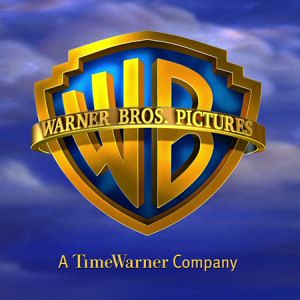
20th Century Fox
The 20th Century Fox logo is very well-known because of the grand, gold building which is surrounded by spot lights which portray a cinema feel. The writing and font is very large and bold which stands out in the evening sky, this could be to symbolise the way people tend to visit the cinema as an evening activity, therefore being very suited to it's purpose. 'Speed' (1994) is an example of a thriller from this production company, it's sub-genre is action. It is about a young cop who must save the passengers of a bus that has a bomb set to explode if the bus goes below 50 MPH. Another example is 'Hide and Seek' (2005) a psychological thriller about a widower who tries to piece together his life in the wake of his wife's suicide, his daughter finds solace at first in her imaginary friend.

The logo for DreamWorks uses bold, white font on a dark background of clouds. Due to the colour contrast of the background and font, the writing stands out a lot more to the audience. Examples of past and future releases of the thriller genre include 'What Lies Beneath' (2000) which is an American supernatural horror-thriller film. It stars a couple who experience a strange haunting that uncovers secrets about their past. 'I Am Number Four' (2011) has a action as the sub-genre. It is about a man who is a fugitive on the run from ruthless enemies sent to destroy him.

Warner Bros. Pictures
The main colours of this logo are gold and blue which are very contrasting colours. The bold letters WB feature in the background, these are well-known and recognisable to many people. One thriller from this production company is 'Deathtrap' (1982) which is about a Broadway playwright who puts murder in his plan to take credit for a student's script. Also, 'A Perfect Murder' (1998) which is a remake of the Hitchcock classic dial "M" for murder.

20th Century Fox
The 20th Century Fox logo is very well-known because of the grand, gold building which is surrounded by spot lights which portray a cinema feel. The writing and font is very large and bold which stands out in the evening sky, this could be to symbolise the way people tend to visit the cinema as an evening activity, therefore being very suited to it's purpose. 'Speed' (1994) is an example of a thriller from this production company, it's sub-genre is action. It is about a young cop who must save the passengers of a bus that has a bomb set to explode if the bus goes below 50 MPH. Another example is 'Hide and Seek' (2005) a psychological thriller about a widower who tries to piece together his life in the wake of his wife's suicide, his daughter finds solace at first in her imaginary friend.

Soundtrack Evaluation
Overall, we think that our soundtrack we produced as a group was fairly successful and we worked well together and produced a good piece of work!
What was successful...
We think that our soundtrack fits really well into the thriller genre and creates a good amount of tension. The tension built from the soundtrack gradually as we started with one beat and added more throughout which we thought worked effectively and gave off the right amount of tension without being too scary! We think that the soundtrack creates a mood which also fits well into the thriller genre.
What could have been better/Improvements...
In order to make our soundtrack better, if we had more time, we could have added more of a dramatic section within or at the end of the soundtrack. This would have added a more dramatic sense of tension and maybe put a bit of a twist into the opening.
Another improvement that would have bettered our soundtrack is if we had a better knowledge of garageband and therefore we could have experimented a little more with the program and added more of a variety and something different rather than using the safe option and keeping it stereotypically to the thriller genre.
What was successful...
We think that our soundtrack fits really well into the thriller genre and creates a good amount of tension. The tension built from the soundtrack gradually as we started with one beat and added more throughout which we thought worked effectively and gave off the right amount of tension without being too scary! We think that the soundtrack creates a mood which also fits well into the thriller genre.
What could have been better/Improvements...
In order to make our soundtrack better, if we had more time, we could have added more of a dramatic section within or at the end of the soundtrack. This would have added a more dramatic sense of tension and maybe put a bit of a twist into the opening.
Another improvement that would have bettered our soundtrack is if we had a better knowledge of garageband and therefore we could have experimented a little more with the program and added more of a variety and something different rather than using the safe option and keeping it stereotypically to the thriller genre.
Wednesday 19 January 2011
Analysis of Sound in Thriller Opening Sequences
For the analysis of sound in thriller opening sequences, we watched 3 film openings...
Catch Me If You Can
This opening did not contain any diegetic sound and consisted of just the soundtrack which is non-diegetic. The soundtrack was jazzy and depending on what was happening in the film, the pace of the sound changed accordingly. For example it tended to speed up at parts in order to build up tension at an important part of the movie, then slowed down again to normal tempo. The music helped to emphasise the sub genre which is crime because where crime was shown the music seemed to draw attention to what was happening on screen.
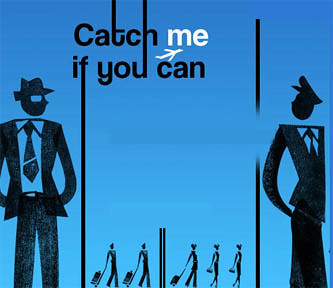

Vertigo
This opening contained both diegetic and non-diegetic sound. Examples of the diegetic sound were noises such as the dialogue of the characters, a gun shot and also the movement of characters. Ambient sound included climbing the ladder. The non-diegetic sound was a soundtrack which was fast paced to convey eagerness and energy, and this fit in because the characters were running. The pitch changed from high to low according to the action happening on screen. We thought the sub-genre was action because the soundtrack was fast paced which shows energy and commotion. This goes along with the crime sub-genre
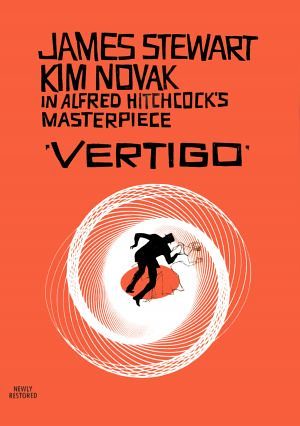

Face Off
The sound played a large part in the opening sequence of this film. When the mood changed the non diegetic music tended to change along with the visuals, for example when he was with his son the mood was happy and content so the sound was the music was more mellow and calm, however when the man with the gun was in shot the atmosphere was dramatically changed by the music because it turned more slow and depressive. Diegetic sound included the shot gun, and when he fell of the horse a sound effect of a horse was played. The sound also fit in with the film because when the man was shot the whole scene was silent. This showed shock and disbelief.
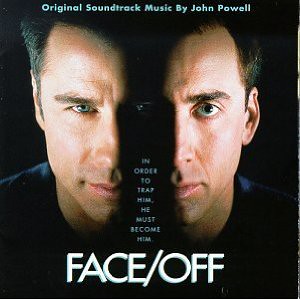

Tuesday 18 January 2011
Previous Group Analysis Q1:12
The group that we decided to analyse was group Q1:12. We chose this group because we thought that there was a lot to comment on the video and planning/research.
Video:
As a group, we looked through the marking criteria for the videos and concentrated on the following points...
- holding a steady shot, where appropriate
- framing a shot, including and excluding elements as appropriate
- using a variety of shot distances as appropriate
- shooting material appropriate to the task set
- selecting mise-en-scene including colour, figure, lighting, objects and setting
- editing so that meaning is apparent to the viewer
- using varied shot transitions and other effects selectively and appropriately for the task set
- using sound with images and editing appropriately for the task set
- using titles appropriately
We decided for the reasons below that an appropriate level for the group's video would be a mid to high Level 3 (44 marks). This criteria states that there is evidence of proficiency in the creative use of the technical skills that are listed above.
Our thoughts....
-The majority of the shots were steady, excluding the shots within the car, however this couldn't really be helped due to it being bumpy and corners having to be turned
-There was good framing of the shots for example over the shoulder shots in the car that were effective because you still had view of the character but also their perspective and their view in the rear view mirror
-This group used a good variety of different shots and shot distances. For example establishing shot when driving around the corner. Also there were a couple of effective close ups for example the character's reflection in the rear view mirror and when the character unlocked the boot
-Mise-en-scene... The lighting could have been darker as it doesn't match to the typical thriller genre, this was evident as the colouring came off brighter than necessary. The setting could have been more deserted or on an abandoned lot as there was constant flow of traffic in the background. Props... The car that was used along with the spliff reflected the character's true personality and the spade which was used as a weapon showed thriller genre conventions when we knew that something bad was going to happen
-Editing... Displayed good continuity as the opening flowed very well right through to the end, making sense the whole way through. Instead of having credits at the beginning/or the end they had them throughout which was effective as it worked well with the footage. We think that the text could have stood out more as it didn't make a huge impression. Also there was a grammatical error where they said "wrote by" and it should have been "written by" however it didn't stand out too much. The cuts used were mainly jump cuts which again worked well with the footage and turned out to be effective. Lastly, for the editing process, the title presented at the end didn't make a huge impression as it was rather dull. In order for it to be more professional, it could have been bigger/bolder etc.
-Sound... we think that the music used in the car was a really good idea and reflected the character's image. This also helped to make an opinion of the character. Although there was no music that stereotypically could have been used for the "thriller" genre, the music that was used was still effective.
Research:
Again as a group we went through the group's blog and decided that it also should be under the level 3 marking scheme.
The layout of the blog was very good and was clearly presented. The titling of the blogs made it really easy to identify what was what within the blog and where the research was. We think that the research that was showed was very detailed and specific. However, we noticed that they could have completed more film research in order to show their understanding of the conventions of the opening sequence for a thriller film.
-Sound... we think that the music used in the car was a really good idea and reflected the character's image. This also helped to make an opinion of the character. Although there was no music that stereotypically could have been used for the "thriller" genre, the music that was used was still effective.
Research:
Again as a group we went through the group's blog and decided that it also should be under the level 3 marking scheme.
The layout of the blog was very good and was clearly presented. The titling of the blogs made it really easy to identify what was what within the blog and where the research was. We think that the research that was showed was very detailed and specific. However, we noticed that they could have completed more film research in order to show their understanding of the conventions of the opening sequence for a thriller film.
Thriller Film Classifications
The thriller film certification is never made under a 12/12a. The reason for this is due to the narratives involving strong content that is unsuitable for a younger audience. This includes content that portrays language or behavior that is discriminating, this could be things such as suicide and self-harming.
We have decided our thriller project will be a classification 15, mainly because it will allow us to be more creative in our content with less constrictions. This may include use of strong language, dangerous behavior with not too much detail. Violence may also be strong but will not dwell upon the infliction of pain.
The reason ours will not be an 18 is because we produce the high standard that is expected of a thriller with the classification 18. The conventions we will use cannot be portrayed to the same level as this classification does, due to the high technology we wont be able to use. Our thriller also won't include breach of criminal laws and which treatment appears to harm in detail.
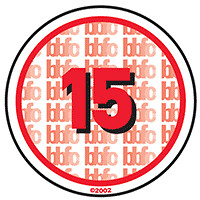
We have decided our thriller project will be a classification 15, mainly because it will allow us to be more creative in our content with less constrictions. This may include use of strong language, dangerous behavior with not too much detail. Violence may also be strong but will not dwell upon the infliction of pain.
The reason ours will not be an 18 is because we produce the high standard that is expected of a thriller with the classification 18. The conventions we will use cannot be portrayed to the same level as this classification does, due to the high technology we wont be able to use. Our thriller also won't include breach of criminal laws and which treatment appears to harm in detail.

Crime + Action Thriller Conventions
The crime and action genre is a hybrid of both crime films and thrillers. These often offer a suspenseful account of a crime or multiple crimes, whether or not they are successful is another question.
These films often focus on the criminal(s) rather than a investigators/police and usually emphasise action over psychological aspects.
Crime and Action Content:
- Serial killers/murders
- Robberies
- Chases
- Shootouts
- Heists
- Double-crosses
These films often focus on the criminal(s) rather than a investigators/police and usually emphasise action over psychological aspects.
Crime and Action Content:
- Serial killers/murders
- Robberies
- Chases
- Shootouts
- Heists
- Double-crosses
An example of a crime thriller is Seven, produced in 1995. This film is about two detectives, a rookie and a veteran who go on a hunt for a serial killer who uses the seven deadly sins as his modus. operandi.
Monday 17 January 2011
Comparing Two Thriller Opening Sequences
Inception.
Within the first five seconds of the trailer there is a shot of who the film is appropriate for, officially done by the film rates, this is therefore the beginning of the staggered roll of credits. The main score begins and the main film production companies are then shown, eg, Legendary pictures, Warner Bros. pictures and Syncopy. Once the main trailer begins the lead character is introduced (Leonardo Dicaprio) along with a combination of narrative and voice explaining him self, this combines and links to the dialogue. A second lead character is introduced only a matter of moments after this and there are shot/reverse shots between them both all linking to the overall explanation of the film. There is a lot of montage throughout, for example near the beginning of the trailer, there is a shot of character one waking down the corridor leading on to a second shot of a shot gun being loaded and then it flicks back to the first shot again. This sequence juxtaposed creates a meaning for the audience, also it manages to introduce the thriller/action aspect of the genre to the audience. Credits are included at around twenty five seconds into the trailer saying who directed it (Christopher Nolan) and giving examples of top films he has also directed such as The Dark Knight which the follows on to introducing the rest of the top characters of the film. From then on there are repeated jump shots added in to the beat of the score creating effect and tension, yet again there is the combination of the voice over and narrative explaining the rest of the story line and how the characters are involved. Just over halfway through the trailer the rest of the credits are shown, displaying the name of the lead actors in the film along with more of the 'intense' scenes which coincide with the score as the tempo increases to a dramatic pace, again creating tension and anxiety, whilst it finishes with the title of the film, and the end credits such as the release date and the film and music producers in small print.Shutter Island
http://www.youtube.com/watch?v=5iaYLCiq5RM
Overall both the films trailers are very similar as they both start with and introduction to key and lead characters who then throughout the trailer explain and generalise the story line and then in the middle of both the trailers they have many jump cuts and a general montage. Then it finishes of with up tempo score and closing credits such as the release date of the film along with the name, the music and film producers etc and both end on a cliff hanger where (lasting around five seconds) a short clip of a scene with high intensity and action occurs.
Thursday 13 January 2011
What is the Difference Between Thriller and Horror? - Extra Research
Thriller Genre
Thrillers tend to build up tension and fear. They are usually suspenseful and don't usually show the violent parts. Obviously killing is involved but most gory parts are left out. A thriller excites the audience in any way such as a car chase.Thrillers are more about pursuit, and the main character is either a hero or an anti-hero whose motivations are explored. Also thrillers usually have little or no supernatural content. An example is 'The Butterfly Effect' which is a psychological thriller.
Horror Genre
Horror makes its excitement in very particular ways, through use of graphic violence and pain. It's more about being scared than being excited like in thrillers. Horror films tend to include a lot of meaningless deaths and they are likely to contain supernatural beings. The genre is characterized by the attempt to make the viewer experience fright, fear, terror, disgust or horror. Its plots often involve the intrusion of an evil force, event, or personage, sometimes of supernatural origin, into the mundane world. A good example of a horror film is the 'Saw' series. It contains a lot of bood and gore and killings with a lot of detail.
Thriller and horror genres are quite similiar however, and some films overlap into both genres.
Political Thriller Conventions
A political genre in a thriller film is one that is set against the background of the political power struggle. The conventions for this vary amongst the other genres. There is many variations of the narrative, usually they involve someone, the protagonist character being given political power while their opponents, the antagonists try and stop them from getting it.
Differences we have identified:
- Can feature innocent people becoming drawn into the political world.
- Characters aim to prove innocence.
- Location tends to focus on different cultures and countries.
- In some cases the use of another character as a helper who provides the protagonist with something useful.
- The use of false heroes, someone we think is the good guy turns out to be the opposite.
An example of a film that portrays this genre is The Contender made in 2000. This features a woman who is nominated to become Vice President following the death of the previous. During the process she becomes a victim of vicious attacks on her personal life resulting in stories from the past being spread, leaving her indecisive to fight back or refuse to comment.
Differences we have identified:
- Can feature innocent people becoming drawn into the political world.
- Characters aim to prove innocence.
- Location tends to focus on different cultures and countries.
- In some cases the use of another character as a helper who provides the protagonist with something useful.
- The use of false heroes, someone we think is the good guy turns out to be the opposite.
An example of a film that portrays this genre is The Contender made in 2000. This features a woman who is nominated to become Vice President following the death of the previous. During the process she becomes a victim of vicious attacks on her personal life resulting in stories from the past being spread, leaving her indecisive to fight back or refuse to comment.
Wednesday 12 January 2011
Sub-Genres of Thrillers - Extra Research
Thriller films are also divided into sub-genres which help to explain the narrative. These can overlap and incorporate other themes. The typical codes and conventions for all genres is the the sound and editing used to build tension and hold us in suspense. As well as this the shots used will usually be quick paced with many camera angle changes.
The fast pace and recurrent action means that there can also be overlapping of these sub-genres:
- Action thriller
- Conspiracy thriller
- Crime thriller
- Disaster thriller
- Drama thriller
- Eco – thriller
- Erotic – thriller
- Horror thriller
- Legal thriller
- Medical thriller
- Political thriller
- Psychological thriller
- Spy thriller
- Supernatural thriller
- Techno – thriller
The thriller film certification is never made under a 12. The reason for this is due to the narratives involving strong content that is unsuitable for a younger audience. This means they are more vulnerable when compared to the way the target audience will be affected by the film.
We plan to investigate further into some of the sub-genres mentioned which we could possibly use in our final thriller project.
The fast pace and recurrent action means that there can also be overlapping of these sub-genres:
- Action thriller
- Conspiracy thriller
- Crime thriller
- Disaster thriller
- Drama thriller
- Eco – thriller
- Erotic – thriller
- Horror thriller
- Legal thriller
- Medical thriller
- Political thriller
- Psychological thriller
- Spy thriller
- Supernatural thriller
- Techno – thriller
The thriller film certification is never made under a 12. The reason for this is due to the narratives involving strong content that is unsuitable for a younger audience. This means they are more vulnerable when compared to the way the target audience will be affected by the film.
We plan to investigate further into some of the sub-genres mentioned which we could possibly use in our final thriller project.
Tuesday 11 January 2011
Textual Analysis of the opening sequence of the film 'Memento'
Monday 10 January 2011
Our Preliminary Task Evaluation
We think that we produced quite a good story-line to our preliminary opening sequence that was effective and fitted well with the thriller genre. Holly and Jade did very well in acting and this helped make our opening sequence more effective. The transitions that we used fitted well with our footage and helped make it look more professional overall. Also the soundtrack that we found built up the right amount of tension that we aimed for and so we were happy with that!
When putting our footage together there were a couple of times where during filming we had moved the camera by accident when re-doing shots and as a result of this there are a couple of jumps within the sequence. This is something we will consider in our final piece in order to show better continuity and make it more professional. Continuity is the main element that we need to improve on for our final piece however we could also use a wider range of shot types and be more careful when we move the camera whilst filming.
Overall we think that our preliminary task turned out quite well. We worked well together as a group and we spread out the amount of work evenly! We learnt how to build tension through the different shots. We also learnt better skills on editing as we experimented with more transitions that on our previous task.
When putting our footage together there were a couple of times where during filming we had moved the camera by accident when re-doing shots and as a result of this there are a couple of jumps within the sequence. This is something we will consider in our final piece in order to show better continuity and make it more professional. Continuity is the main element that we need to improve on for our final piece however we could also use a wider range of shot types and be more careful when we move the camera whilst filming.
Overall we think that our preliminary task turned out quite well. We worked well together as a group and we spread out the amount of work evenly! We learnt how to build tension through the different shots. We also learnt better skills on editing as we experimented with more transitions that on our previous task.
Friday 7 January 2011
Subscribe to:
Posts (Atom)





